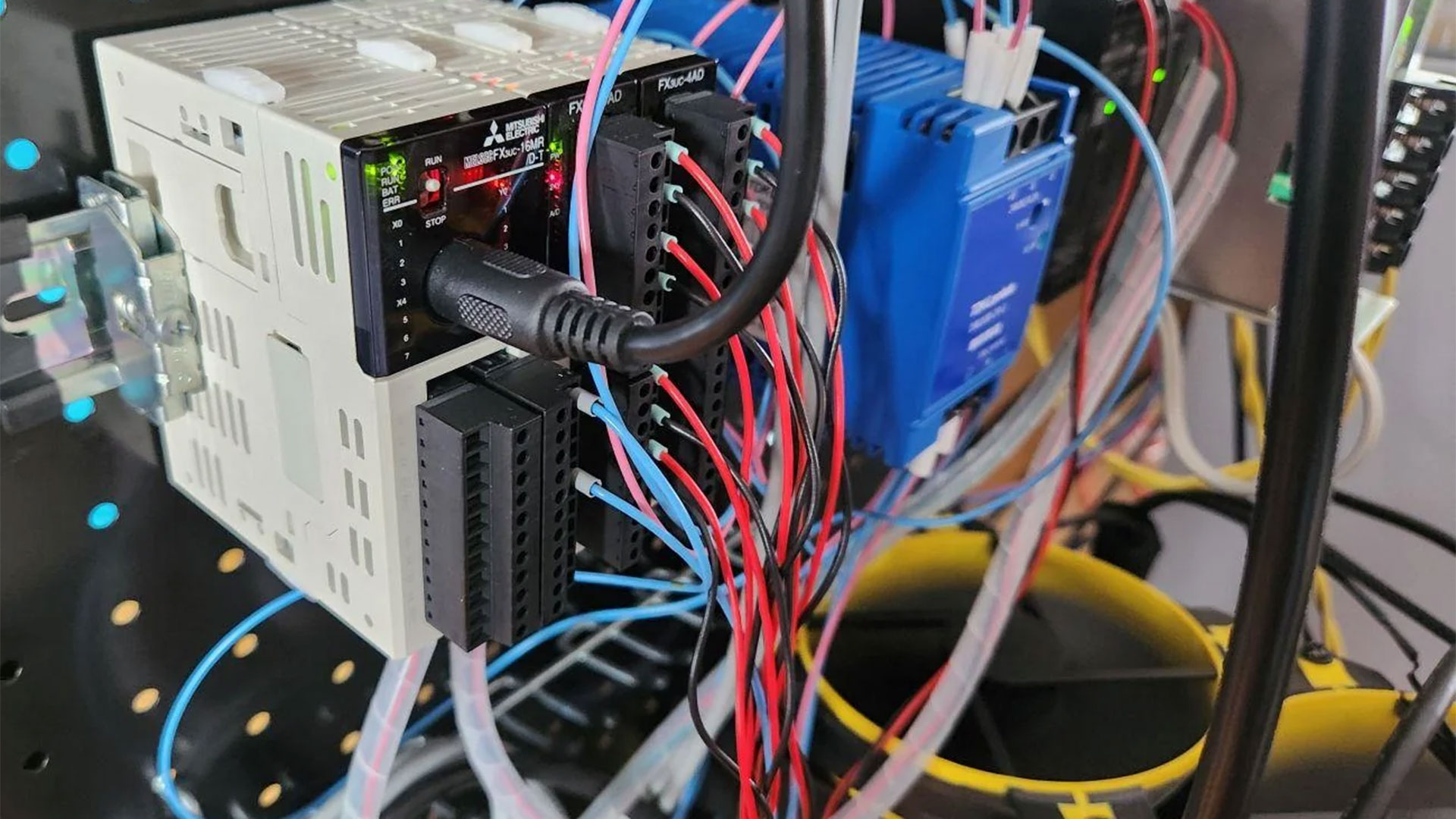DIYer creates ‘RTX 5090 countermeasures’ with cabling spaghetti to mitigate 16-pin meltdowns — system automatically shuts down when the overcurrent protection is triggered
Don’t look, unless you have a devil-may-care attitude to cable management.

A PC enthusiast has created a DIY “RTX 5090 Countermeasures” system to prevent thermal damage to GPU power connectors.
Redditor Electronic_Ear6797 showcased their cabling spaghetti creation in an eye-popping gallery earlier today. The system, designed to prompt the PSU to power down if an overcurrent event is sensed, would make Rube Goldberg (or Heath Robinson) envious. Others may prefer to consider off-the-shelf power monitoring solutions, such as the WireView GPU series from Thermal Grizzly.
The potential for thermal damage occurring in systems packing high-power graphics cards remains a clear and present danger in mid-2025. A swell of melting power connector reports arrived alongside the Nvidia RTX 4090 in late 2022, and confoundingly continued with the next-gen RTX 5090 launched at the start of this year.
With clearly not enough action being taken by component designers and makers to ensure a PC doesn’t self-combust, some people will feel the need to take things into their own hands. This is the void where Electronic_Ear6797’s cabling countermeasures were conjured up.
Sadly for us nosy folk, the Redditor hasn’t created reference resources, where we can unpick the concept behind their chaotic-looking countermeasures, look at schematics, and so on. All we have is a handful of images and a system specs list.
RTX5090 Countermeasures for Connector Thermal Damage from r/nvidia
On the specs list, we can see typical off-the-shelf PC parts from well-known brands. There’s a Zotac Gaming GeForce RTX 5090 AMP Extreme Infinity GPU, and a Corsair HXi Series HX1500i PSU. One of Corsair’s 12VHPWR cables has the delicate job of ferrying watts between these two components.
Further on the list are some clues to the construction of the ‘RTX 5090 countermeasures’ system, though. We see there is a Mitsubishi Electric MELSEC FX3UC-16MR/D-T PLC, a Mitsubishi Electric MELSEC FX3UC-4AD×2 analog unit, a QNHCK2-16×6 current sensor, and a G7L-2A-B DC24 (64-3375-02) power relay squirreled among the nest of cabling.
Get Tom's Hardware's best news and in-depth reviews, straight to your inbox.
While some commentators were appreciative of the meisterwerk presented by Electronic_Ear6797, others were less enamored with the design and aesthetics. Yet more social media suggestions asked why a simple fuse system wasn’t preferred, or why using one of Thermal Grizzly’s neat WireView products wasn’t sufficient.
If the ‘RTX 5090 countermeasures’ system works as intended and prevents a power pin-spiked meltdown, the work will have been worthwhile. However, it has sometimes proven difficult for even seasoned overclockers and experts to replicate cable melting problems intentionally. In other words, the Redditor might never have experienced cable melting issues with this system anyway. Though it is better to be safe than sorry.
Follow Tom's Hardware on Google News to get our up-to-date news, analysis, and reviews in your feeds. Make sure to click the Follow button.

Mark Tyson is a news editor at Tom's Hardware. He enjoys covering the full breadth of PC tech; from business and semiconductor design to products approaching the edge of reason.
-
TechieTwo IMO it's absurd that the melting RTX 5xxx connector issue wasn't immediately resolved. This ain't rocket science. This is predominently a design issue. All parties involved should have addressed this issue especially as it's clearly a safety issue.Reply -
valthuer While the “RTX 5090 Countermeasures” project might look like a chaotic tangle of wires, it’s a fascinating example of enthusiasts taking hardware safety into their own hands. Sure, it may lack the polish of commercial solutions like Thermal Grizzly’s WireView, but it shows genuine creativity and engineering effort. Whether or not it ever actually prevents a meltdown, it’s a reminder that DIY innovation often thrives where manufacturers fail to address persistent problems. Sometimes safety comes not in a neat box, but in a spaghetti mess that works.Reply -
chaz_music ReplyTechieTwo said:IMO it's absurd that the melting RTX 5xxx connector issue wasn't immediately resolved. This ain't rocket science. This is predominently a design issue. All parties involved should have addressed this issue especially as it's clearly a safety issue.
Well, that is the issue, because it is actually very nuanced and yet a very common engineering error in power flow. It isn't rocket science, but it IS complex to those who don't understand it. Number 1 is don't parallel cables/wiring without derating or without some enforced balancing, and not trust paralleled resistances. Even the US building codes with the NEC require derating paralleled AC cabling, sometimes to 40%! With AC it is not only resistance that causes sharing issues, but also cable inductance.
With my background in power electronics, I see these kind of design errors all the time. I have been following this problem for a while and it make me think of design groups/management who don't do good design reviews or try to get external reviews to catch their blind spots. Also with these GPU connectors, there is a disregard for connector science and derating itself. It takes someone with a ton of experience to get this right, and an engineer doing this who is from another disciple is likely to get it wrong. Reminds me of the early PoE days.
The solution from Thermal Grizzly at least catches some of the problems and can help save the day, although I don't think their product automatically shuts of your PC. This really should be built into the GPU. Even Thermal Grizzly misses the next problem:
But there's more ...
There was a story earlier this week in which a guy undervolted a GPU (took less power) and yet it still managed to die, and it took out the motherboard as well. and even cascaded to other components. Once I thought about it, I realized that using the old "common grounding" in the ATX PSU has a serious flaw with this kind of high current GPU structure. There could be more to this particular story, but it at least did shine a light on the grounding problem I found.
These high power usage GPUs and ATX PSU systems have created a huge ground loop system, which also includes the motherboard and its ATX power connector. If these GPU cables have failures in the return wires (GPU ground cabling to PSU), the intended return power path starts to get higher and higher resistance. The GPU return current can divert to the ground return through the PCIe connector and into the motherboard ground plane. Those paths are not designed for that much bulk current. In the case of this story, it is possibly what damaged the motherboard (here on TH):
https://www.tomshardware.com/pc-components/gpus/zotac-rtx-5090-reportedly-catches-fire-during-battlefield-6-session
So we can throw a ground loop issue into this unfolding story. I hope they find a fix for this soon. There are possibly 5-6 good design paths to help this (as I figure right now), but all are going to cost money. -
valthuer Replychaz_music said:Well, that is the issue, because it is actually very nuanced and yet a very common engineering error in power flow. It isn't rocket science, but it IS complex to those who don't understand it. Number 1 is don't parallel cables/wiring without derating or without some enforced balancing, and not trust paralleled resistances. Even the US building codes with the NEC require derating paralleled AC cabling, sometimes to 40%! With AC it is not only resistance that causes sharing issues, but also cable inductance.
With my background in power electronics, I see these kind of design errors all the time. I have been following this problem for a while and it make me think of design groups/management who don't do good design reviews or try to get external reviews to catch their blind spots. Also with these GPU connectors, there is a disregard for connector science and derating itself. It takes someone with a ton of experience to get this right, and an engineer doing this who is from another disciple is likely to get it wrong. Reminds me of the early PoE days.
The solution from Thermal Grizzly at least catches some of the problems and can help save the day, although I don't think their product automatically shuts of your PC. This really should be built into the GPU. Even Thermal Grizzly misses the next problem:
But there's more ...
There was a story earlier this week in which a guy undervolted a GPU (took less power) and yet it still managed to die, and it took out the motherboard as well. and even cascaded to other components. Once I thought about it, I realized that using the old "common grounding" in the ATX PSU has a serious flaw with this kind of high current GPU structure. There could be more to this particular story, but it at least did shine a light on the grounding problem I found.
These high power usage GPUs and ATX PSU systems have created a huge ground loop system, which also includes the motherboard and its ATX power connector. If these GPU cables have failures in the return wires (GPU ground cabling to PSU), the intended return power path starts to get higher and higher resistance. The GPU return current can divert to the ground return through the PCIe connector and into the motherboard ground plane. Those paths are not designed for that much bulk current. In the case of this story, it is possibly what damaged the motherboard (here on TH):
https://www.tomshardware.com/pc-components/gpus/zotac-rtx-5090-reportedly-catches-fire-during-battlefield-6-session
So we can throw a ground loop issue into this unfolding story. I hope they find a fix for this soon. There are possibly 5-6 good design paths to help this (as I figure right now), but all are going to cost money.
Just out of sheer curiosity: my 5090 MSI connector got burned recently and i was wondering if there's any particular reason why only half of the pins are burned.
Shouldn't they all have been destroyed?
Thank you in advance for your time.
-
Dr3ams This is what I can get for 2600 Euros:Reply
- Mainboard: Asus B850-Plus WIFI
- CPU: AMD Ryzen 7 9800X3D
- CPU cooler: bequiet! Dark Rock 5
- RAM: Kingston Fury DDR5-6000 32GB
- SSD: 1x WD 1 TB (M.2)
- SSD: 1x WD 2 TB (M.2)
- GPU: XFX Radeon RX 7900 XT 20 GB 320 Bit
- Case: bequiet! Silent Base 802
- PSU: bequiet! 850 watt platinum
- Mouse: Logitech G502X
- Keyboard: Logitech G915X
- Speakers: Logitech Z623 2.1
- Display: Asus ROG Strix 27" 4K IPS 160Hz panel
For 2600 Euros I can get a complete high-end gaming PC. So why would I waste that money on a single GPU that melts like ice cream. -
jackt 5 questions:Reply
- Have nvidia been fined forthe 4xxx gen cable problem ?
- Why nvidia has been allowed to commercialize the 5xxx gen ?
- Will nvidia be fined forthe 5xxx gen cable problem ?
- Has someone made a class action for the 4 or 5 gen cable problem ?
- why nvidia hasnt been forced to recall and fix all the 4 and 5 gen cards ? -
Amdlova Reply
No one cares about some gamers with a melting problem...jackt said:5 questions:
- Have nvidia been fined forthe 4xxx gen cable problem ?
- Why nvidia has been allowed to commercialize the 5xxx gen ?
- Will nvidia be fined forthe 5xxx gen cable problem ?
- Has someone made a class action for the 4 or 5 gen cable problem ?
- why nvidia hasnt been forced to recall and fix all the 4 and 5 gen cards ?
You will not see this problem on a controlled ambient on a enterprise side :)
I keep my old 8 pins here.